Glass From the Ancient
World
by Bob Brooke
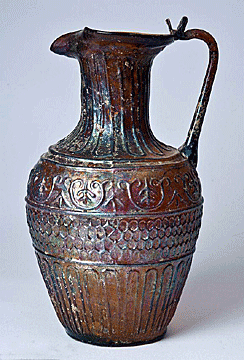 Ancient
Rome will once again come alive at the Corning Museum of Glass when
it mounts an exhibition devoted to ancient mold-blown glass. The
exhibition will feature works from the early first century A.D to
the 7th century A.D.—600 years after the innovations of Roman
glassmaker Ennion. Ancient
Rome will once again come alive at the Corning Museum of Glass when
it mounts an exhibition devoted to ancient mold-blown glass. The
exhibition will feature works from the early first century A.D to
the 7th century A.D.—600 years after the innovations of Roman
glassmaker Ennion.
Embedded within the main exhibit is another, Ennion and his Legacy:
Mold-Blown Glass from Ancient Rome, which will explore the diversity
of Roman mold-blown glass, which was traded across the Mediterranean
world. The exhibit, which opens on May 16, 2015 and runs through
January 4, 2016, will also reveal the stories these vessels tell
about the ancient world—from the development of the perfume and oil
trade to the celebrity culture surrounding gladiators and Roman
empresses.
On display will be 129 works, including highlights from the Museum’s
collection of ancient glass, along with loans from the Metropolitan
Museum of Art and other international public and private
collections. The exhibit will illustrate the relationship between
mold-blown glass vessels and their counterparts in ceramic and
metal, which had been shaped in molds for centuries. The Romans
introduced the use of molds in glassmaking at the end of the 1st
century B.C., shortly after the introduction of glassblowing—a
revolutionary breakthrough that made the production of vessels
faster and simpler. Roman glassmakers quickly adapted the molds,
which had been used to shape ceramic and metal objects, for
glassblowing and enabled quicker manufacturing processes,
standardization of size, the production of multiples, and more
elaborate, intricate designs than those seen previously in ceramic
or metal.
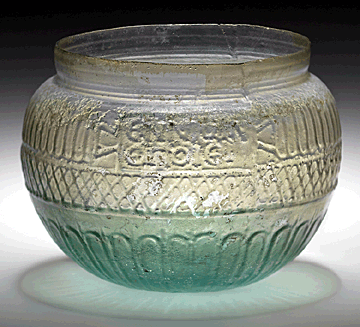 The
Corning Museum of Glass is home to the most comprehensive collection
of Roman glass in the world. The images depicted on these pieces
reveals what was important in popular culture in the ancient
world—from the gods to favorite gladiators. In addition, mold-blown
glass played an important role in the ancient marketplace. Back
then, capacity of storage vessels varied. But the uniformity of
mold-blown vessels ensured that consumers got what they paid for. The
Corning Museum of Glass is home to the most comprehensive collection
of Roman glass in the world. The images depicted on these pieces
reveals what was important in popular culture in the ancient
world—from the gods to favorite gladiators. In addition, mold-blown
glass played an important role in the ancient marketplace. Back
then, capacity of storage vessels varied. But the uniformity of
mold-blown vessels ensured that consumers got what they paid for.
The glass vessels from the ancient Roman world are diverse in size,
shape, and decoration. Some designs have direct links to religion,
mythology, and literature, while others contain images and
inscriptions that identify gladiators and were sold as souvenirs at
the arena.
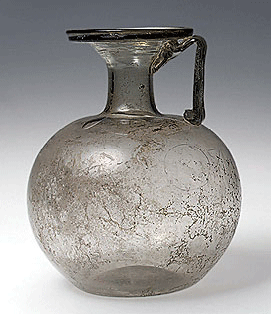 One
of the most common surviving of mold-blown objects is perfume
bottles. A One
of the most common surviving of mold-blown objects is perfume
bottles. A
variety of colors among the surviving examples have led scholars to
speculate that the colors may have played a role in marketing
different scents.
There are also examples of a popular form known as a “janiform” head
flask, or vessels with two faces placed back to back. These flasks
were inspired by the Roman god Janus, who presided over beginnings
and endings, and thus was used as a guardian of doorways; Janus was
represented as a double-faced head.
Vessels, believed to be souvenirs from chariot races and
gladiatorial combats, are noted for their inscriptions, naming the
participants at the events.
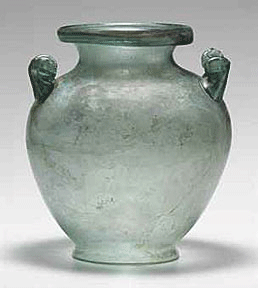 Much
of what scholars know today about mold-blown glass they learned from
careful observation of the vessels themselves, noting the location
of the mold seams, and using these same seams to identify how many
parts of a mold glassmakers used to shape the glass. The exhibition
will also feature a new video on Roman mold-blowing glass techniques
to illustrate how the manufacture of these vessels may have been
achieved. Very few molds have survived from antiquity, so modern
glassmakers have attempted to recreate ancient techniques by using
the designs of ancient vessels to replicate molds and create ancient
style glass vessels with them. Much
of what scholars know today about mold-blown glass they learned from
careful observation of the vessels themselves, noting the location
of the mold seams, and using these same seams to identify how many
parts of a mold glassmakers used to shape the glass. The exhibition
will also feature a new video on Roman mold-blowing glass techniques
to illustrate how the manufacture of these vessels may have been
achieved. Very few molds have survived from antiquity, so modern
glassmakers have attempted to recreate ancient techniques by using
the designs of ancient vessels to replicate molds and create ancient
style glass vessels with them.
Embedded within The Corning Museum of Glass-organized exhibition is
the Metropolitan Museum of Art-organized exhibition, Ennion: Master
of Glass, which brings together 24 of the 50 known, still surviving
works by Ennion, a glass artist who was active in the mid-first
century A.D. It will be on view through October 19, 2015.
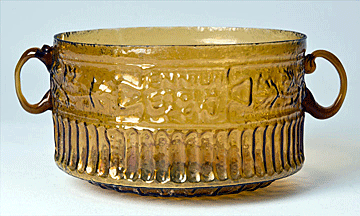 Ennion
produced the finest mold-blown glass in antiquity and historians
presume he was the owner and master craftsman of a glass workshop
located somewhere in the eastern Mediterranean region, perhaps in
Sidon, a site in modern-day Lebanon. He was the first glass artist
to sign his works, incorporating into his designs a prominent
inscription in Greek that reads: "Ennion Made (It)." Beyond Ennion’s
name, little is known about the man or his workshop. His wares have
been found throughout the ancient Roman world, attesting to their
desirability. Ennion
produced the finest mold-blown glass in antiquity and historians
presume he was the owner and master craftsman of a glass workshop
located somewhere in the eastern Mediterranean region, perhaps in
Sidon, a site in modern-day Lebanon. He was the first glass artist
to sign his works, incorporating into his designs a prominent
inscription in Greek that reads: "Ennion Made (It)." Beyond Ennion’s
name, little is known about the man or his workshop. His wares have
been found throughout the ancient Roman world, attesting to their
desirability.
Other inscribed works in the exhibit include the names of their
makers, such as Aristeas, Neikais, and Jason. The show will explore
Ennion’s legacy in a variety of ways, including his artistic
influence on the medium, his successful attempt to promote himself
and his workshop through a uniform signature, and the ancient
stories revealed by his decorative and figural designs.
<
Back to Antiques News Archives
Next Article >
|
